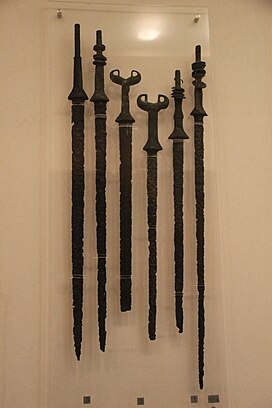A sword is an edged, bladed weapon intended for manual cutting or thrusting. Its blade, longer than a knife or dagger, is attached to a hilt and can be straight or curved. A thrusting sword tends to have a straighter blade with a pointed tip. A slashing sword is more likely to be curved and to have a sharpened cutting edge on one or both sides of the blade. Many swords are designed for both thrusting and slashing. The precise definition of a sword varies by historical epoch and geographic region.

A rapier or espada ropera is a type of sword used in Renaissance Spain to designate a sword with a straight, slender and sharply pointed two-edged long blade wielded in one hand. It was widely popular in Western Europe throughout the 16th and 17th centuries as a symbol of nobility or gentleman status.

The hilt is the handle of a knife, dagger, sword, or bayonet, consisting of a guard, grip and pommel. The guard may contain a crossguard or quillons. A tassel or sword knot may be attached to the guard or pommel.
This is a list of types of swords.

A longsword is a type of European sword characterized as having a cruciform hilt with a grip for primarily two-handed use, a straight double-edged blade of around 80 to 110 cm, and weighing approximately 1 to 1.5 kg.

Dao are single-edged Chinese swords, primarily used for slashing and chopping. They can be straight or curved. The most common form is also known as the Chinese sabre, although those with wider blades are sometimes referred to as Chinese broadswords. In China, the dao is considered one of the four traditional weapons, along with the gun, qiang (spear), and the jian, called in this group "The General of Weapons".

The small sword or smallsword is a light one-handed sword designed for thrusting which evolved out of the longer and heavier rapier of the late Renaissance. The height of the small sword's popularity was during the 18th century, when any civilian or soldier with pretensions to gentlemanly status would have worn a small sword daily.
The French estoc is a type of sword, also called a tuck in English, in use from the 14th to the 17th century. It is characterized by a cruciform hilt with a grip for two-handed use and a straight, edgeless, but sharply pointed blade around 36 to 52 in in length. It is noted for its ability to pierce mail armor.
A flame-bladed sword or wave-bladed sword has a characteristically undulating style of blade. The wave in the blade is often considered to contribute a flame-like quality to the appearance of a sword. The dents on the blade can appear parallel or in a zig-zag manner. The two most common flame-bladed swords are rapiers or Zweihänders. A flame-bladed sword was not exclusive to a certain country or region. The style of blade can be found on swords from modern-day Germany, France, Spain, and Switzerland.

Swordsmanship or sword fighting refers to the skills and techniques used in combat and training with any type of sword. The term is modern, and as such was mainly used to refer to smallsword fencing, but by extension it can also be applied to any martial art involving the use of a sword. The formation of the English word "swordsman" is parallel to the Latin word gladiator, a term for the professional fighters who fought against each other and a variety of other foes for the entertainment of spectators in the Roman Empire. The word gladiator itself comes from the Latin word gladius, which is a type of sword.
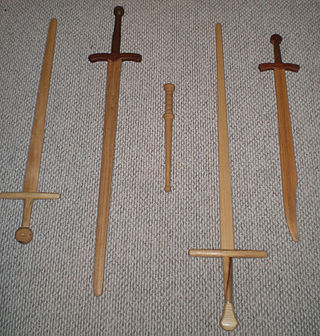
In martial arts, a waster is a practice weapon, usually a sword, and usually made out of wood, though nylon (plastic) wasters are also available. Nylon is safer than wood, due to it having an adequate amount of flex for thrusts to be generally safe, unlike wooden wasters. Even a steel feder has more flex than most wooden wasters. The use of wood or nylon instead of metal provides an economic option for initial weapons training and sparring, at some loss of genuine experience. A weighted waster may be used for a sort of strength training, theoretically making the movements of using an actual sword comparatively easier and quicker, though modern sports science shows that an athlete would most optimally train with an implement which is closest to the same weight, balance, and shape of the tool they will be using. Wasters as wooden practice weapons have been found in a variety of cultures over a number of centuries, including ancient China, Ireland, Iran, Scotland, Rome, Egypt, medieval and renaissance Europe, Japan, and into the modern era in Europe and the United States. Over the course of time, wasters took a variety of forms not necessarily influenced by chronological succession, ranging from simple sticks to clip-point dowels with leather basket hilts to careful replicas of real swords.
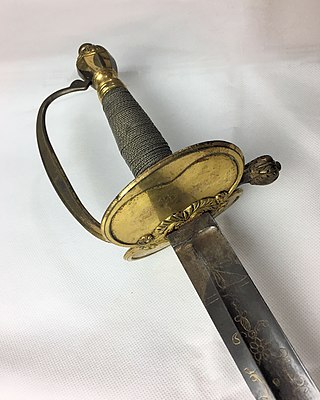
A spadroon is a light sword with a straight-edged blade, enabling both cut and thrust attacks. This English term first came into use in the early 18th century, though the type of sword it referred to was in common usage during the late 17th century. They were primarily used as a military sidearm in the late 17th and early 18th centuries, and for officers and NCOs in the latter part of the 18th and early 19th centuries. The type of sword also saw widespread use across Europe and America, though the term 'spadroon' is unique to the Anglophone world.
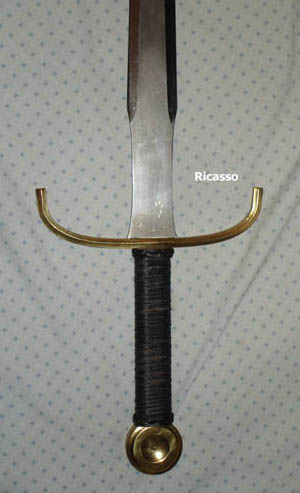
A ricasso is an unsharpened length of blade just above the guard or handle on a knife, dagger, sword, or bayonet. Blades designed this way appear at many periods in history in many parts of the world and date back to at least the Bronze Age — essentially, as long as humans have shaped cutting tools from metals.

The Oakeshott typology is a way to define and catalogue the medieval sword based on physical form. It categorises the swords of the European Middle Ages into 13 main types, labelled X through XXII. The historian and illustrator Ewart Oakeshott introduced it in his 1960 treatise The Archaeology of Weapons: Arms and Armour from Prehistory to the Age of Chivalry.

The Zweihänder, also Doppelhänder ("double-hander"), Beidhänder ("both-hander"), Bihänder, or Bidenhänder, is a large two-handed sword that was used primarily during the 16th century.
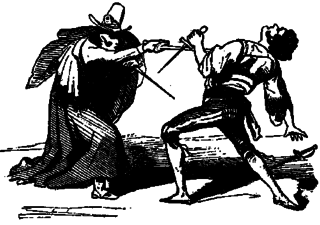
The parrying dagger is a category of small handheld weapons from the European late Middle Ages and early Renaissance. These weapons were used as off-hand weapons in conjunction with a single-handed sword such as a rapier. As the name implies they were designed to parry, or defend, more effectively than a simple dagger form, typically incorporating a wider guard, and often some other defensive features to better protect the hand as well. They may also be used for attack if an opportunity arises. The general category includes two more specific types, the sword breaker and trident dagger.

A claymore is either the Scottish variant of the late medieval two-handed sword or the Scottish variant of the basket-hilted sword. The former is characterised as having a cross hilt of forward-sloping quillons with quatrefoil terminations and was in use from the 15th to 17th centuries.

The basket-hilted sword is a sword type of the early modern era characterised by a basket-shaped guard that protects the hand. The basket hilt is a development of the quillons added to swords' crossguards since the Late Middle Ages. In modern times, this variety of sword is also sometimes referred to as the broadsword.
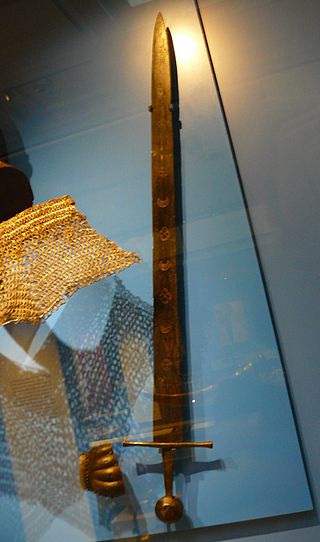
In the European High Middle Ages, the typical sword was a straight, double-edged weapon with a single-handed, cruciform hilt and a blade length of about 70 to 80 centimetres. This type is frequently depicted in period artwork, and numerous examples have been preserved archaeologically.
This is a glossary of terms used in fencing.


